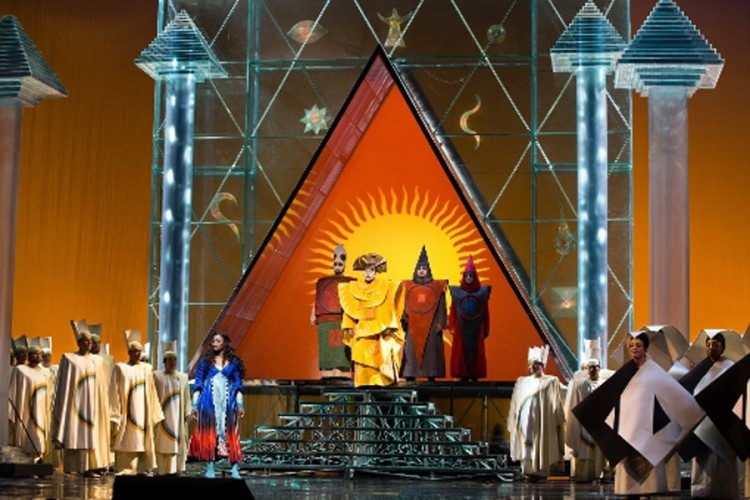
Julie Taymor’s brilliant production of The Lion King opened in 1997 and is the highest grossing Broadway production of all time. The closest thing she’s directed since then is the Metropolitan Opera’s The Magic Flute.
Here again are birds and beasts impersonated by singer/actors. Colorful puppets and kites float across the sky, controlled by the motions of actors below. Breathtaking projections extend above the heads of actors, and face masks are raised and lowered to give the illusion that humans are animals lunging at one another.
The production’s imaginative look fits the comedy composed by Mozart during the last year of his life. His The Magic Flute is partly a celebration of Masonry, partly a romantic fantasy and partly a slapstick street comedy. Some productions are tedious as they shift back-and-forth among these genres. Taymor’s take focuses on the fanciful, and it’s great fun.
A family-friendly version of this production, trimmed to 100 minutes, debuted in 2006 and was shown again this holiday season in HD at movie theaters. I expect it will have many future re-showings.
George Tsypin’s set is full of Masonic symbols, like multiple triangles hanging in asymmetrical patterns, and it also simulates the opera’s Egyptian locale.
This Magic Flute is visually a delight and the singing is, for the most part, excellent. Most impressive are the Hungarian coloratura Erika Miklosa as the Queen of the Night, the Chinese lyric soprano Ying Huang as Pamina and the German bass René Pape as Sarastro. They sang superbly and acted their roles appealingly.
See Miklosa’s big aria, courtesy of the Metropolitan Opera, by clicking here: https://vimeo.com/32480022
Nathan Gunn as the bird-catcher Papageno prompts a mixed reaction. He is a fine singer and actor, yet his characterization was over the top, which plays well in the cavernous Met but appears hammy when enlarged in close-up. Yet Gunn receives huge applause from those in the opera house.
Even more problematic was the Tamino of tenor Matthew Polenzani. That fine artist looked awkward with his hair tied in a bun reminiscent of a Samurai warrior. On top of that, his enunciation of words was stilted. While Gunn threw himself exuberantly into his role, Polenzani seemed uncomfortably out of his element. It’s not one of the highlights of his career, yet here it is preserved for eternity.
For opera lovers of all ages, this is an excellent version of Die Zauberflöte. In J. D. McClatchy’s singable English translation, it makes all of the dramatic points and cuts the dull sections of the original German text with its hodge-podge of elements that bump awkwardly against each other.
For any viewer who may wonder why this production retains so many references to Freemasonry, keep in mind how important it was to Mozart. The number 3 is a big part of Freemasonry and he emphasized that with three chords in the overture, three Ladies serving the queen, three Boys who lead Tamino and Papageno on their quest, three knocks on the doors of the temple, three flats in the key signature of E flat, three trombones and the time signature of Sarastro’s aria is in 3/4.
Read other reviews on The Cultural Critic